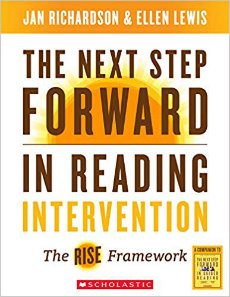Quick and Effective Reading Intervention
The Next Step Forward in Reading Intervention: The RISE Framework
By Jan Richardson and Ellen Lewis
(Scholastic 2018 – Learn more)
 Reviewed by Michelle Voelker
Reviewed by Michelle Voelker
Middle school is a tough time for anyone. Period. Now imagine being a kid who has been labeled “below grade level” in reading. It makes those tough years tougher. Knowing this, I am always on the lookout for ways to bring my own students up to level so they can have the confidence to read and grow.
I found that and more in The Next Step Forward in Reading Intervention. It contains a wealth of knowledge and intentional lessons set forth by two educators who have dedicated their work to growing students as readers.
 The goal of this book is simple: provide ready-to-use lessons for short-term, small-group interventions. Depending on the level of student you are working with, either the phonics stage, or the comprehension stage, there is a RISE or RISE Up model for you.
The goal of this book is simple: provide ready-to-use lessons for short-term, small-group interventions. Depending on the level of student you are working with, either the phonics stage, or the comprehension stage, there is a RISE or RISE Up model for you.
The authors’ main focus for these models is a logical one: the more times a student can interact with a single text, the better. To do that, they focus each session on a particular literacy skill, and have students work on that skill three to four times in a session, depending on their level.
The results they have found from implementing this framework seem to speak for themselves. According to their field studies, data from “…over 1,000 students in more than 20 schools indicate that the average lift from RISE is one text level every two weeks,” (p.13).
This book is short – only six chapters – but with TONS of resources to help implement the RISE framework. There is also a lovely digital component available through Scholastic’s website that can be accessed with the password from the book. Like most professional books, this one starts with context and also explains some of the theory behind the framework. (That theory can be found in Jan Richardson’s book, The Next Step Forward in Guided Reading.)
Collaborating on stations
Both RISE and RISE Up work best if taught in stations that are laid out in the chapters. There are four stations for levels C-N and three stations for levels O-Z. Chapters 2 and 4 provide a basic outline of RISE and RISE Up, with an explanation of what each step of the process will look like.
What I especially loved about those chapters is the focus on the need to collaborate with all team members looking to further the child’s skills. So often we think of ourselves as isolated in the process of educating our students, but there are so many other stakeholders to work with. This book does a great job of not only laying out some benefits of working as a team, but also laying out what a team meeting should look like after lessons are taught.
An abundance of easy-to-use tips
Chapters 3 and 5 get into the practicality of the models. While reading these chapters, I thought about how I would have loved a guide like this as a brand new teacher. They are easy to follow and have tips along the way to make your life easier and your teaching more effective. There are simple tips like: “Put copies of the text in plastic sleeves so students can use dry-erase markers to record their notes. That way, you can reuse articles and stories,” (p 109).
There are tips geared toward actual teaching moves too: “As the children retell, point to the graphics on the Story Retelling Rope. This reduces the amount of talking you do and expands the amount they do,” (p. 47). Those kind of gems are life savers to new teachers, and maybe even a great reminder to the more seasoned veteran.
Meeting the needs of students
In addition to tips, there is a guide on how to select students for intervention, ideas for where to locate stations, lists of materials needed for each station, pictures to show what a station should look like, and examples of how teachers should record notes on student progress throughout the eight-week intervention.
The authors have even anticipated the needs of students down to how they might act when presented with certain readings and are afraid to take risks, or if a student is not monitoring the text for meaning, among other things. To go with each situation is a list of ideas for how to push the student to succeed with either scripts a teacher can follow or ideas of tasks for helping them move forward.
The one downfall of this framework is that to implement the stations as suggested in the book, multiple adults are needed for each small group. So, if you are working with students leveled C-N and a four station model is needed for the intervention, four adults are also needed. While it would be ideal, not every school has the people power to implement that type of intervention. But fear not! The authors anticipated this and provided an adaptation that allows for the classroom teacher to provide 40-minute lessons instead.
Finally, this book is just full of resources. Everything is reproducible, and downloadable from Scholastic.com. Throughout the book, while explaining each part of the lesson, are references to appropriate appendices. In addition to those are links to videos that show teachers working with the students in a particular station for a particular skill.
The result: More confident readers
As I mentioned before, this is a book for both novice teachers and seasoned veterans. There is an abundance of information here that will convince even the most skeptical that reading intervention can be done quickly if done intentionally and with all partners working in agreement.
When all is said and done, your students will exit intervention with the confidence they need to excel as readers. So, go forth, read this book, and get students at your school to succeed as readers!
Michelle Voelker is a 7th grade English and World History teacher at an urban school in Sacramento, CA. This past summer she was a fellow with Area 3 Writing Project in their Summer Institute and is now a teacher leader, providing workshops on writing in the history classroom. Before becoming a teacher, Michelle was an AmeriCorps member for a program that provided reading intervention on Title I elementary campuses. Since then, she has worked to make sure that every kid loves to read and acquires the skills needed to become a lifelong reader.

































